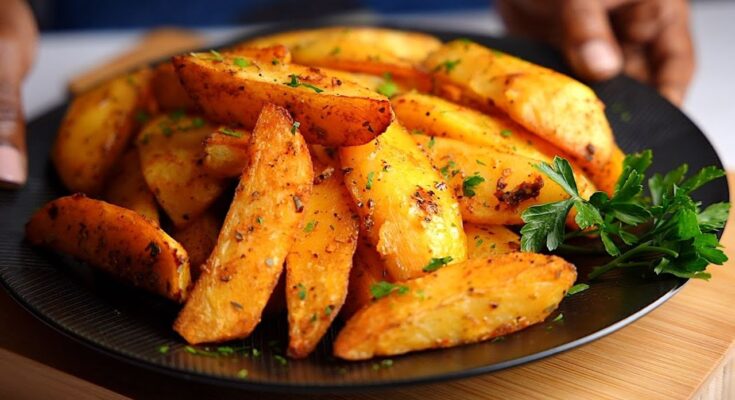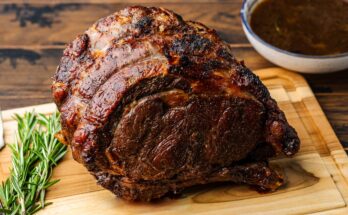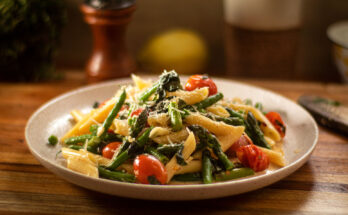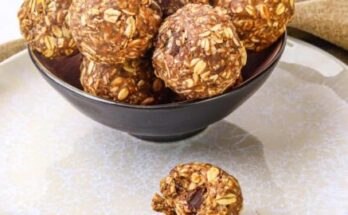Potato Wedge Recipe: Potato wedges are one of those timeless comfort foods that never go out of style. Whether you’re serving them as a side dish for burgers, grilled chicken, or enjoying them on their own with a flavorful dip, they’re always a hit. These golden, crispy-on-the-outside and fluffy-on-the-inside delights can easily be made at home with a few simple ingredients and techniques.
What makes potato wedges so special is their versatility. You can bake them, fry them, or even air fry them for a healthier version. Season them with salt and pepper for a classic taste, or go bold with paprika, garlic powder, and chili flakes for a spicier kick. The possibilities are endless, and the results are always satisfying.
In this guide, you’ll learn everything from choosing the right type of potatoes to seasoning and cooking them perfectly. Get ready to make restaurant-style potato wedges right in your kitchen!
Why Potato Wedges Are Everyone’s Favorite Snack
Potato wedges are universally loved because they hit all the right notes — crispy, soft, salty, and full of flavor. Unlike fries, wedges have a rustic charm. They’re chunkier, which means you get more of that soft, fluffy potato interior. Plus, they hold onto seasonings and sauces much better due to their wider surface area.
They’re perfect for any occasion — from movie nights and game days to casual family dinners. You can pair them with ketchup, mayonnaise, garlic aioli, or even cheese sauce. Another reason they’re so popular is their simplicity. With just a few pantry staples, you can whip up a batch in under an hour.
And let’s not forget, potato wedges can be made healthier! By baking or air-frying them, you get all the crispiness without deep-frying. That’s why this recipe works for everyone — comfort food lovers and health-conscious eaters alike.
The Secret to Perfectly Crispy and Fluffy Potato Wedges
The magic behind great potato wedges lies in the perfect balance between crispiness and fluffiness. The trick is in the preparation. Soaking the cut potatoes in cold water removes excess starch, ensuring they turn out extra crispy once cooked. Parboiling or lightly steaming them before baking also helps achieve that soft interior.
Oil choice matters too. Using a high smoke point oil like olive oil or sunflower oil gives the wedges a beautiful golden color without burning. Season generously — salt, pepper, paprika, and garlic powder bring out the flavor.
Another secret? Don’t overcrowd the pan. Give your wedges space to crisp up evenly. Flip them halfway through cooking to make sure both sides get that perfect crunch. Follow these steps, and you’ll never have soggy wedges again!
Ingredients You’ll Need
Before we start cooking, let’s gather everything you need for this irresistible potato wedge recipe.
Essential Ingredients for Classic Potato Wedges
Here’s what you’ll need for a serving of 4–5 people:
- 4 large russet or Yukon gold potatoes (washed and unpeeled for that rustic touch)
- 3 tablespoons olive oil (or any vegetable oil)
- 1 teaspoon garlic powder
- 1 teaspoon paprika
- ½ teaspoon black pepper
- 1 teaspoon salt (adjust to taste)
- ½ teaspoon dried oregano or thyme (optional but adds a nice aroma)
Optional Add-ons for Extra Flavor
Want to spice things up? Try these additions:
- 1 teaspoon chili powder or cayenne pepper for a spicy version
- Grated Parmesan cheese for a cheesy twist
- Freshly chopped parsley or coriander for garnish
- Lemon zest for a refreshing tang
These ingredients come together to create the perfect mix of crispiness, flavor, and aroma that will make your wedges absolutely irresistible.
Step-by-Step Guide to Making Potato Wedges
Now that you’ve got your ingredients ready, it’s time to make those golden beauties! Follow this detailed step-by-step guide to ensure perfect results every time.
Step 1 – Choosing the Right Potatoes
Start with firm, starchy potatoes like Russet or Yukon Gold — they crisp up beautifully on the outside while staying fluffy inside. Avoid waxy potatoes, as they tend to stay too firm and don’t absorb seasoning as well.
Step 2 – Washing and Cutting the Potatoes
Scrub the potatoes thoroughly to remove dirt (no need to peel them — the skin adds flavor and texture). Slice each potato in half lengthwise, then cut each half into 3–4 thick wedges, depending on size. Try to keep them uniform so they cook evenly.
Step 3 – Soaking for Extra Crispiness
Place the cut wedges in a bowl of cold water and soak for at least 30 minutes. This helps remove excess starch, which is key for getting that irresistible crunch. Drain and pat them completely dry with a clean towel before seasoning.
Step 4 – Seasoning the Potato Wedges
Toss the dried wedges in a large bowl with olive oil, salt, black pepper, paprika, garlic powder, and a sprinkle of herbs like rosemary or thyme. Coat evenly so every wedge gets a flavor boost.
Step 5 – Baking or Frying: Which Method is Better?
For baking: Preheat your oven to 425°F (220°C). Arrange the wedges on a parchment-lined baking sheet in a single layer and bake for 35–40 minutes, flipping halfway through until golden and crispy.
For frying: Heat oil in a deep pan to 350°F (175°C). Fry the wedges in batches for about 5–6 minutes until golden brown, then drain on paper towels. Both methods deliver crisp perfection — baking is healthier, frying is indulgent. Your call!
Step 6 – Cooling and Serving the Wedges
Let the wedges cool slightly so they stay crisp and don’t steam themselves soft. Serve hot with ketchup, aioli, or spicy mayo. Golden, crispy, and full of flavor — these potato wedges are the ultimate comfort snack!
Tips for the Best Potato Wedges
Making great potato wedges isn’t rocket science, but a few tips can elevate your recipe from good to restaurant-quality.
- Choose the Right Potato: Russet or Yukon Gold potatoes work best for that ideal balance of crispiness and fluffiness.
- Don’t Skip the Soak: Removing starch is crucial for texture.
- Dry Thoroughly: Even a little water can ruin crispiness.
- Use Enough Oil: Lightly coat every wedge so they roast evenly.
- Flip Halfway Through: This ensures both sides get crispy and golden.
- Don’t Overcrowd the Pan: Give each wedge room to breathe and brown properly.
- Serve Immediately: Wedges taste best when hot and fresh out of the oven or fryer.
Want to take your wedges to the next level? Sprinkle them with smoked paprika or chili-lime seasoning after baking. It adds a zesty twist that’s perfect for parties or gatherings.
The Best Dipping Sauces to Serve With Potato Wedges
A great dip can make your potato wedges unforgettable. Here are some delicious options to try:
- Classic Ketchup: A timeless favorite that pairs perfectly with crispy potatoes.
- Garlic Aioli: Creamy, garlicky, and slightly tangy—ideal for garlic lovers.
- Spicy Mayo: Mix mayonnaise with a few drops of hot sauce or sriracha for a kick.
- Cheese Sauce: Melted cheddar or nacho cheese adds richness and decadence.
- Ranch Dressing: Cool and creamy, ranch balances the wedge’s crispy texture.
- Sweet Chili Sauce: Perfect for those who love a sweet and spicy combo.
For a gourmet twist, try truffle mayo or herbed sour cream. You can even experiment with homemade dips like roasted red pepper hummus or avocado crema for something refreshing and healthy.
Nutritional Information
Potato wedges may taste indulgent, but when prepared properly, they can also be a balanced addition to your diet. The nutritional value largely depends on the cooking method you choose—baking, frying, or air-frying—and the amount of oil used.
Here’s an approximate breakdown for one serving (about 6–8 wedges, baked version):
| Nutrient | Amount (per serving) |
|---|---|
| Calories | 180–200 kcal |
| Carbohydrates | 32 g |
| Protein | 4 g |
| Fat | 6 g |
| Fiber | 3 g |
| Sodium | 250 mg |
| Potassium | 600 mg |
| Vitamin C | 20% of Daily Value |
Baked potato wedges are naturally lower in fat compared to fried ones. They retain essential nutrients like potassium, vitamin C, and fiber from the skin. Potatoes also provide complex carbohydrates that give your body sustained energy.
If you opt for air frying, you can cut calories and fat even more without losing the crisp texture. Using olive oil instead of vegetable oil adds healthy monounsaturated fats that are good for your heart.
Pro Tip: To make your wedges even healthier, serve them with Greek yogurt-based dips instead of mayonnaise or cheese sauces. You can also sprinkle flax seeds or chia seeds over the wedges before baking for a light, nutty crunch.
Health Benefits of Potatoes
Potatoes often get a bad reputation, but they’re actually full of nutrients when prepared the right way. Let’s look at why this humble vegetable deserves more love:
- Rich in Vitamins and Minerals: Potatoes are a great source of vitamin C, B6, and potassium—nutrients essential for immunity, nerve function, and blood pressure regulation.
- High in Fiber: Especially when eaten with the skin, potatoes aid digestion and help keep you full longer.
- Energy Booster: The complex carbohydrates in potatoes provide long-lasting energy without spiking blood sugar levels.
- Antioxidant Properties: Potatoes contain antioxidants like flavonoids and carotenoids that help fight free radicals and reduce the risk of chronic diseases.
- Naturally Gluten-Free: Perfect for those with gluten sensitivities or celiac disease.
The key is moderation. When baked or air-fried, potato wedges can be part of a balanced, healthy diet. Avoid overloading them with cheese, butter, or excess salt, and you’ve got yourself a satisfying, guilt-free treat.
Calories and Nutritional Breakdown
Let’s take a deeper look into the nutritional composition of potato wedges based on cooking methods:
| Cooking Method | Calories (per 100g) | Fat (g) | Carbs (g) | Protein (g) |
|---|---|---|---|---|
| Baked (with olive oil) | 130 | 3 | 25 | 3 |
| Air-Fried | 120 | 2 | 26 | 3 |
| Deep-Fried | 220 | 12 | 25 | 3 |
As you can see, baked and air-fried versions are significantly lighter than the deep-fried ones. That’s why most home cooks prefer baking—they get the same crispiness with half the calories and a lot less oil.
If you’re tracking your macros, potato wedges can fit easily into your meal plan as a healthy carb source. Pair them with grilled chicken or fish and a fresh salad for a balanced, wholesome meal.
FAQs about Potato Wedge Recipe
1. Can I Make Potato Wedges Ahead of Time?
Yes, you can! Parboil and season the wedges, then store them in an airtight container in the refrigerator for up to 24 hours. When ready, just bake or air-fry them until crispy.
2. How Do I Store Leftover Potato Wedges?
Let them cool completely before storing in an airtight container. Keep them in the fridge for up to 3 days. Reheat in an oven or air fryer at 400°F (200°C) for 5–7 minutes to restore their crispiness.
3. What Potatoes Are Best for Wedges?
Russet and Yukon Gold potatoes work best due to their starchy texture and fluffy interior. Waxy potatoes like red or new potatoes don’t crisp up as well.
4. Can I Make Potato Wedges in an Air Fryer?
Absolutely! Air fryers make amazing wedges. Preheat to 400°F (200°C), arrange wedges in a single layer, and cook for 15–18 minutes, shaking halfway through. You’ll get crispy results with minimal oil.
5. How Do I Get Extra Crispy Potato Wedges?
Soak the wedges in cold water for at least 30 minutes, dry them thoroughly, and bake at a high temperature (425°F/220°C). Don’t overcrowd the pan and flip them halfway for even crispiness.
Conclusion
There you have it—a complete guide to making the perfect potato wedges right in your kitchen. From choosing the best potatoes and seasoning them to perfection, to baking or frying them for the ultimate crunch, you now have everything you need to impress your family or guests.
Remember, the secret lies in the details: soaking to remove starch, seasoning generously, and cooking them at the right temperature. Once you master these steps, your wedges will turn out golden, crispy, and mouthwateringly delicious every single time.
So, grab some potatoes, heat up that oven, and get cooking—because homemade potato wedges are always worth the effort.



